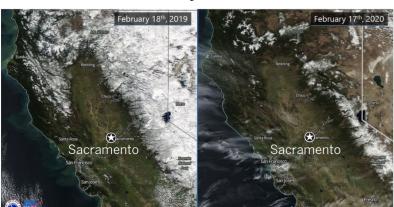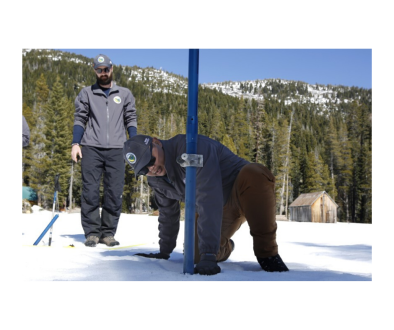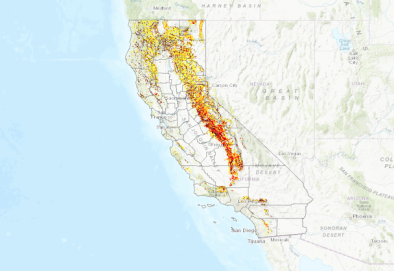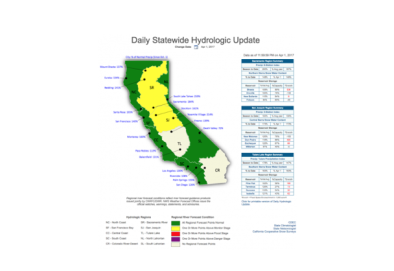
Southwestern US Precipitation Decrease
There is considerable evidence that changing weather patterns linked to climate change are at least partly responsible for recent precipitation decrease in California and the southwestern US. There is also emerging evidence showing that climate change is shifting rainfall patterns, consistent with literature that projects climate change will lead to drying in the region by mid-century.
Read MoreMar 4, 2020 | The New York Times
California Had Its Driest February on Record. Here’s How Bad It Was.

Mar 3, 2020 | Los Angeles Times
California's super-dry February raises specter of early fires and drawn-down reservoirs

Feb 28, 2020 | Los Angeles Times
California snowpack depleted amid what could be a record-dry February

Sep 5, 2017 | Cal Fire | US Forest Service
California Tree Mortality Viewer

Apr 4, 2017 | California Climate Tracker
California Temperature and Precipitation
Apr 4, 2017 | California Department of Water Resources
California Daily Statewide Hydrologic Update

Mar 10, 2021 | Nature Climate Change
Human influence on joint changes in temperature, rainfall and continental aridity
Jun 15, 2018 | Geophysical Research Letters
Attributing the US Southwest's recent shift into drier conditions
May 30, 2018 | Geophysical Research Letters
Effect of Reduced Summer Cloud Shading on Evaporative Demand and Wildfire in Coastal Southern California
Climate science at a glance
- In the past few decades, rainfall has diminished in the western US, and the causes are an active area of research.
- Warming in the northern Pacific contributes to weather patterns that lead to hotter-drier conditions in the western US.
- Weather patterns linked to climate change are at least partly responsible for the dramatic precipitation decrease from 2012-2014 during the California drought.
- Models project that climate change will lead to drying in the Southwest by mid-century.
- There is some evidence that a drying trend linked to climate change is already underway.[1]
Southwest decreased precipitation trends and climate change
- (Diffenbaugh et al. 2015; Park et al. 2015): Changing weather patterns due to climate change are at least partly responsible for the dramatic precipitation decrease during the two back-to-back winters in California—the winters of 2012-2013 and 2013-2014—that contributed to the severity of the California drought. Researchers have linked climate change to the circulation patterns that produced the unprecedented high-pressure weather pattern known as the “ridiculously resilient ridge” that blocked storms from the state.[2][3]
- (Prein et al. 2016): Data from 1979 to 2014 shows up to a 25 percent decrease in precipitation in the US Southwest related to an increase in high pressure, anticyclonic conditions during this time in the North East Pacific.[4]
- (IPCC AR5, 2013): Globally, models show that many mid-latitude and subtropical dry regions will see a decrease in precipitation by 2100 should global emissions continue to increase.[5]
Studies attribute decreases in Southwest precipitation to climate change
- (Bonfils et al. 2020): There is an indication that climate change is already shifting rainfall in the Southwestern US. While human emissions of aerosols in the 1950s shifted the tropical rainbelt (ITCZ) and led to a wetter Western US, climate change-driven warming in the Northern Hemisphere has now offset that cooling trend, returning the Western US to drier conditions. Further warming is likely to lead to even further dry conditions.[1]
- The strength and frequency of the MJO have increased over the past century (medium confidence) (Oliver 7 and Thompson, 2012; Maloney et al., 2019; Cui et al., 2020) because of global warming
Earth Systems Signals
Global warming is causing widespread and rapid changes in the atmosphere, ocean, cryosphere and biosphere.
Heat Signals
The Earth is getting hotter due to human activities that release heat-trapping gases into the atmosphere.
Drought Signals
Climate change is making droughts more likely to occur, and more severe when they do.
Wildfires Signals
Climate change is increasing the size, frequency, intensity and seasonality of wildfires.
Hurricanes Signals
Warmer temperatures increase the rate of water evaporation, which feeds moisture and energy into storms.
Floods Signals
Worsening floods due to climate change are putting a growing number of communities at risk.








